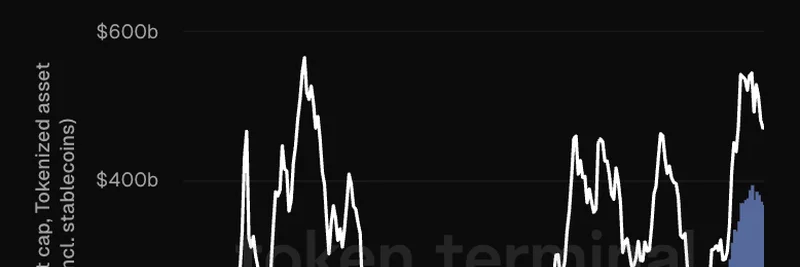If you've been keeping an eye on the crypto space, you know Ethereum is more than just a blockchain—it's a bustling ecosystem where real value gets created and traded. A recent post from Token Terminal on X (original tweet) highlights something fascinating: the market cap of tokenized assets on Ethereum has been acting as a solid floor for ETH's own market cap. Let's break this down in simple terms and see why it matters, especially if you're into meme tokens.
The chart above, shared by Token Terminal, shows two lines over time from 2021 to 2025. The blue area represents the market cap of tokenized assets on Ethereum (including stablecoins), while the green line marks ETH's fully diluted market cap. What's striking is how the tokenized assets' value seems to underpin ETH's price floor. As more assets get tokenized—like turning real-world stuff into digital tokens on the blockchain—Ethereum's overall value gets a boost.
What Are Tokenized Assets Anyway?
Tokenized assets are basically real-world or digital items represented as tokens on a blockchain. Think stablecoins like USDC or USDT, which are pegged to the dollar and make up a huge chunk of this market. But it goes beyond that to include things like tokenized real estate, stocks, or even art via NFTs. On Ethereum, these tokens live as ERC-20 or other standards, making them easy to trade, lend, or use in DeFi protocols.
DeFi, short for decentralized finance, is where a lot of this action happens. It's like traditional banking but on the blockchain—no middlemen, just smart contracts handling loans, swaps, and yields. Token Terminal points out that stablecoins and DeFi are key drivers here, and as more assets get tokenized, Ethereum becomes even more indispensable.
Why This Sets a Floor for ETH's Market Cap
Here's the crux: Ethereum isn't just a currency; it's the infrastructure powering all these tokenized assets. Every transaction, swap, or minting on the network burns a bit of ETH (thanks to EIP-1559) and generates fees that validators earn. So, the more value locked in tokenized assets, the more activity on the chain, which directly supports ETH's price.
Imagine Ethereum as a digital real estate platform. The more properties (tokenized assets) listed and traded on it, the more valuable the platform itself becomes. Token Terminal's data shows this floor effect clearly—the tokenized market cap has been rising steadily, even during crypto winters, providing a baseline for ETH's valuation. As of late 2025, with tokenized assets pushing toward hundreds of billions, ETH's market cap benefits from this built-in demand.
The Connection to Meme Tokens
Now, you might be wondering how this ties into meme tokens, our specialty here at Meme Insider. Meme coins like DOGE-inspired tokens or the latest viral sensations are often built on Ethereum or compatible chains. They're a fun, speculative form of tokenized assets themselves! When a meme token goes viral, it drives massive on-chain activity—trades, liquidity pools, and community engagement—all of which contribute to Ethereum's usage.
Plus, as traditional assets get tokenized, it creates a more mature ecosystem where meme tokens can thrive alongside stablecoins and DeFi. Think about it: easier access to tokenized dollars means smoother entry for retail investors into meme plays. If Ethereum's floor rises, it could mean more stability and growth potential for the entire meme token market, reducing some of the wild volatility we all love (and sometimes hate).
Looking Ahead: More Tokenization Means More Growth
Token Terminal's insight is a reminder that Ethereum's strength lies in its utility. With ongoing upgrades like layer-2 scaling solutions (check out Optimism or Arbitrum for faster, cheaper transactions), expect even more assets to flock to the network. Governments and big institutions are already dipping toes into tokenization—BlackRock's BUIDL fund is a prime example.
For meme token enthusiasts, this is exciting. A stronger Ethereum means better infrastructure for launching and trading memes. Keep an eye on projects blending memes with real utility, like those incorporating DeFi elements or tokenized community assets. If you're building or investing in the space, understanding these dynamics can give you an edge.
What do you think—will tokenized assets push ETH to new highs? Drop your thoughts in the comments, and stay tuned to Meme Insider for more breakdowns on how blockchain trends impact the meme world.

